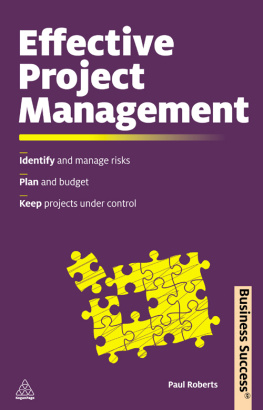
execution
>> create the vision
>> implement the plan
>> get the job done
Tom Gorman

Copyright 2007 F+W Publications. All rights reserved.
This book, or parts thereof, may not be reproduced in any form without permission from the publisher; exceptions are made for brief excerpts used in published reviews.
Published by Adams Business, an imprint of Adams Media, an F+W Publications
Company, 57 Littlefield Street, Avon, MA 02322
www.adamsmedia.com
ISBN 10: 1-59869-118-X
ISBN 13: 978-1-59869-118-4
eISBN: 978-1-44051-660-3
Printed in Canada.
J I H G F E D C B A
Library of Congress Cataloging-in-Publication Data
Gorman, Tom.
Execution / Tom Gorman.
p. cm.
ISBN-13: 978-1-59869-118-4 (pbk.)
ISBN-10: 1-59869-118-X (pbk.)
1. Management. 2. Business planning. I. Title.
HD31.G67 2007
658dc22 2007018987
This publication is designed to provide accurate and authoritative information with regard to the subject matter covered. It is sold with the understanding that the publisher is not engaged in rendering legal, accounting, or other professional advice. If legal advice or other expert assistance is required, the services of a competent professional person should be sought.
From a Declaration of Principles jointly adopted by a Committee of the American
Bar Association and a Committee of Publishers and Associations
Many of the designations used by manufacturers and sellers to distinguish their product are claimed as trademarks. Where those designations appear in this book and Adams Media was aware of a trademark claim, the designations have been printed with initial capital letters.
This book is available at quantity discounts for bulk purchases.
For information, please call 1-800-289-0963.
contents
Part 1
MANAGING PLANS AND PEOPLE
chapter 1
Execution: The Way to Get Things Done
chapter 2
Managing People: Principles and Practices
chapter 3
Planning Precedes Execution
chapter 4
Managing Yourself: Using Your Time Wisely
chapter 5
Parts of a Business and What They Do
Part 2
MANAGING MONEY, PROJECTS, AND PROCESSES
chapter 6
Managing Money: Income, Outgo, Profit, and Loss
chapter 7
Making Sound Decisions
chapter 8
Delivering Quality and Value
chapter 9
Executing Marketing Plans
Part 3
MANAGING GROWTH, SETBACKS, ANDSUCCESS
chapter 10
Growing a Business
chapter 11
Problem Solving and Troubleshooting
introduction
The Way to GetThings Done
Execution. Productivity. Results. Accomplishments. These are the outcomes of good, solid management. Management is the art and science of getting things done through other people, and thats what this book is about. Its about managing people, money, processes, and resources whether you are in a company, a nonprofit organization, or on your own.
Thats why we call it execution. Its not really about management in the Big Company sense of the term you know, going to meetings, playing politics, having lunch, and so on. Execution is about getting things done. If you work in management in a large organization, or want to, you will benefit more by being able to execute than you will by sitting through meetings, playing politics, and all of that. Thats because the key skill in any job today is getting the job done (although youll probably still have to sit through meetings).
There are certain ways to go about getting the job done, regardless of the job. Getting the job done involves decision making, planning, scheduling, organizing people and resources, managing money, moving things forward, and controlling quality, among other tasks and skills. These tasks and skills are generic in the sense that there are proven ways to go about these activities that work in virtually any setting and situation.
Those are the skills you will learn in this book, which will enable you to executeto get things done through other people or on your own. Sometimes the people you will need to get things done through wont actually be on your staff. In todays world of lean organizations, entrepreneurial start-ups, and virtual working arrangements, people may work as full-time, part-time, or temporary employees, or as independent contractors or freelancers. They may know more about what they do than you ever will, and they may even be smarter than you in some ways.
Thats okay. In real life, execution rarely works the way it does in movies. In the movies, an executive (someone who executes the organizations plans) tells subordinates what to do, and they do it. Meanwhile, in real life, people may or may not report to the executive, probably wont just follow orders, and will always need more in the way of direction than someone yelling, Just get it done! Also, unlike the movies, you cant go around asking, Why am I surrounded by idiots?or pulling guns on people for that matter. In real life you must know how to execute plans, not people.
Executive Skills
Other key business and life skills are covered in other books in this Adams Media series, such as Innovation, Persuasion , and Motivation. Here in Execution, we deal with the nuts and bolts of getting things done. Here you will learn methods, skills, and tools of decision making, planning, goal setting, scheduling, budgeting, follow-up, and quality control. You will also learn how to manage yourself, and how to understand and solve problems that inevitably occur when you try to get something done.
This book is organized into three parts:
Part 1: Managing Plans and People shows how to define and communicate goals and ways of reaching them, and explains the functions of a business even a one-person businessand how to set them up. It also shows how to set yourself up for success by managing your time well and getting help when you need it.
Part 2: Managing Money, Projects, and Processes reveals the basics of budgeting and finance, and shows how to go about public relations and marketing, which are becoming key to success in almost any endeavor. This part also covers proven decision-making and project management tools.
Part 3: Managing Growth, Setbacks, and Success shows how to grow a project or a business into something that can sustain itselfand your ambitionsand how to identify and deal with troubleshooting as opposed to problem solving.
This book recognizes that business and all other forms of organizational life have evolved and are continuing to evolve. Therefore the formula for success, and for getting things done, has evolved. But certain tools, methods, and frameworks, such as profit and loss, cause and effect, and planning and execution always apply. They just need to be updated from time to time.
Who Am I?
Ive been a middle-manager in divisions of two Fortune 500 companies and, for the past ten years, have been a full-time freelance business writer focused mainly on books that I write under my own name and for clients who require ghostwriting and editorial services. I also hold an MBA from New York Universitys Leonard N. Stern School of Business.
As a corporate manager I was fortunate to work for some excellent senior managers, as well as a few who could be described as negative role modelsmanagers who taught me what not to do. I held a variety of positions in marketing and product management, including director of product development in one company and director of publication services for a $50 million consulting firm. So Ive managed people in project-oriented situations, which have a beginning, middle, and end, and in process-oriented situations, which never end because you continually produce the same product or service for customers or for stakeholders within the company.
Next page










